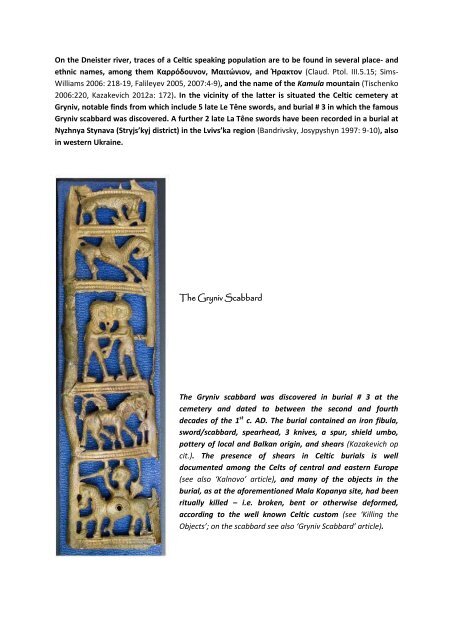gallo-scythians
gallo-scythians
gallo-scythians
Create successful ePaper yourself
Turn your PDF publications into a flip-book with our unique Google optimized e-Paper software.
On the Dneister river, traces of a Celtic speaking population are to be found in several place- andethnic names, among them Καρρόδουνον, Мαιτώνιον, and Ήρακτον (Claud. Ptol. III.5.15; Sims-Williams 2006: 218-19, Falileyev 2005, 2007:4-9), and the name of the Kamula mountain (Tischenko2006:220, Kazakevich 2012a: 172). In the vicinity of the latter is situated the Celtic cemetery atGryniv, notable finds from which include 5 late Le Têne swords, and burial # 3 in which the famousGryniv scabbard was discovered. A further 2 late La Têne swords have been recorded in a burial atNyzhnya Stynava (Stryjs’kyj district) in the Lvivs’ka region (Bandrivsky, Josypyshyn 1997: 9-10), alsoin western Ukraine.The Gryniv ScabbardThe Gryniv scabbard was discovered in burial # 3 at thecemetery and dated to between the second and fourthdecades of the 1 st c. AD. The burial contained an iron fibula,sword/scabbard, spearhead, 3 knives, a spur, shield umbo,pottery of local and Balkan origin, and shears (Kazakevich opcit.). The presence of shears in Celtic burials is welldocumented among the Celts of central and eastern Europe(see also ‘Kalnovo’ article), and many of the objects in theburial, as at the aforementioned Mala Kopanya site, had beenritually killed – i.e. broken, bent or otherwise deformed,according to the well known Celtic custom (see ‘Killing theObjects’; on the scabbard see also ‘Gryniv Scabbard’ article).


